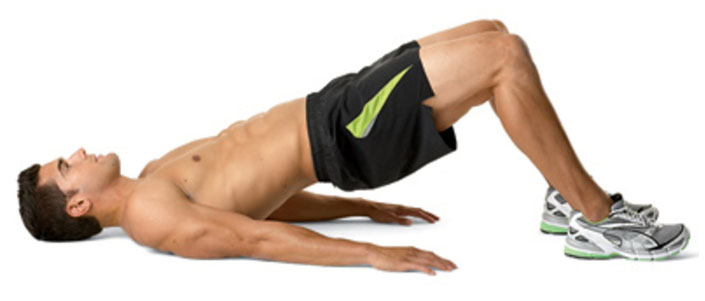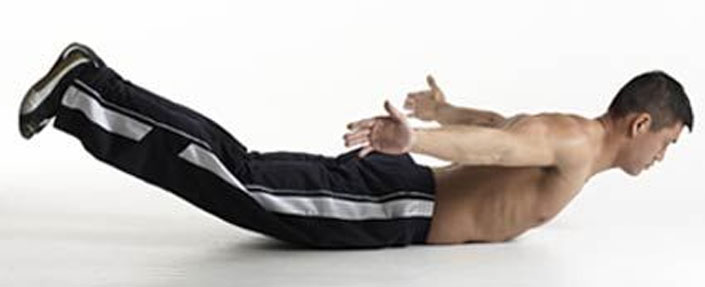
It's nothing new to have somebody tell you that a strong core will help your cycling - but did anybody ever tell you why? Today we look at some exercises that can improve your core strength and posture in just 5 minutes a day, but first let's examine why we should bother.
Having a good base of core strength will help transfer more power to the pedals by providing a solid platform for the lower body to push against - just picture your core as way of developing more leverage for each pedal stroke, directing the power from your legs into the pedals without any effort being wasted.
Pilates exercises are targeted to develop strength in the deep intrinsic muscles of the abdomen and spine, taking pressure off the superficial muscles and promoting more balanced and efficient use. This especially supports the lower back, which is an area many riders complain about during time trials or longer road rides. So, a stronger core translates directly into more power, less fatigue, and better posture on the bike - better posture leads to less fatigue, which results in more sustained power, which then... well, you get the idea.
Five minutes a day may sound a bit unrealistic, but if you integrate the following exercises into your daily post-ride routine (or TV-watching routine, or whatever), you will gain significant core strength. Cycling is all about incremental gains and this extra strength could be just the thing to lift you to the next grade within your club or to get you through your next Gran Fondo without lower back pain.
The Plank

How To Do It
- Place elbows directly under shoulders and keep forearms parallel.
- Pull in your core muscles by sucking in your stomach as if you were trying to squeeze into a pair of jeans a size too small, and hold that position steady.
- Lift up onto your toes creating a straight line through shoulder, hip, knee, and ankle joints, and hold that position. Even though the plank is a basic exercise, don't underestimate it. It will challenge your core and place your deep stabilizing muscles under considerable isometric tension. Try holding this position for 1 minute.
If you need more variety or challenge, try a side plank:
- Lie on your right side, with your right elbow under your shoulder, forearm in front for stability, and stack your left foot on your right. Raise your left arm over your head.
- In one motion, lift your hips to create a straight line down your left side. Lower your hips a few inches off the floor; do 10 to 15 reps, then switch sides.
Both Plank variations are going to help you maintain upper body strength while sprinting or climbing, as well as being able to hold a TT position comfortably for longer periods of time, as well as strong obliques to improve your stability in the saddle.
Floor Bridge

How To Do It
- Lay on your back on the floor, making sure your feet are shoulder-width apart and flat on the floor. Lift pelvis and squeeze glutes until the knees, hips, and shoulders are all in line.
- Slowly lower your pelvis down around until you are an inch off the floor. Repeat 15 times.
To increase the challenge, lift one foot an inch or so off the floor before you begin, and try to complete the exercise as if you had both feet on the floor - keep your hips stable, and control your movement.
As simple as it may be, the Floor Bridge is incredibly effective at activating the glutes and the stabilizing muscles of the lower back.
The Boat

How To Do It
- Sit on the floor, resting both hands lightly behind you, and lean back until your torso is at a 45-degree angle.
- Keeping your legs together, lift them off the floor as you extend your arms forward at shoulder height. Keep your abs tight, and let your thighs and torso form a 90-degree angle. If your hamstrings are tight, you'll need to bend your knees a little. Work up to holding for 1 minute.
Just like the plank, the boat pose builds the lower-back stability and core strength needed to remain bent over the handlebar for hours, or to blast up hills without compromising power or speed.
Prone Snow Angels

How To Do It
- Lie face-down, arms extended along your sides. Gently squeeze your glutes and slowly raise your feet, chest, and hands no more than six inches off the floor. Sweep your arms overhead and separate your feet. Try to touch your hands above your head. Return to the start position, relaxing your feet, chest, and arms.
- Repeat slowly 15 to 20 times.
A comprehensive movement that connects key cycling muscles, the Snow Angel works your glutes, lower back, mid-back and shoulders.
None of these movements are very complex, nor are they taxing enough to affect your on-the-bike training, but by doing each of them for just a minute per day you'll build a fantastic core without spending valuable hours in the gym - hours that you should be spending out riding!

RELATED ARTICLE:
The Foam Roller - Awesome recovery in 5 minutes a day
For fast recovery of stiff, sore muscles and a quick return to top riding condition, you need to get yourself on a roll!Without the benefit of a full-time masseur like the pro riders enjoy, the next best thing for cyclists is self-massage with a foam roller... READ MORE


